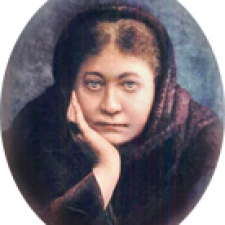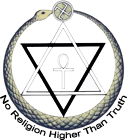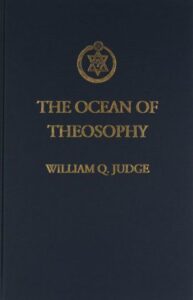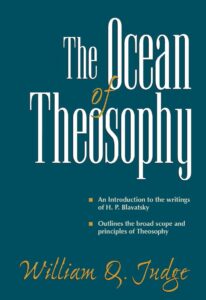Studies In The Ocean of Theosophy Part XXII
Theosophy Magazine
Vol. 22, No. 10 August 1934
pages 461- 464
Part XXII
UNDERSTANDING of death proves it to be life: Theosophy’s teachings regarding the after-death states bring home thus forcefully the fact of individual immortality. The correspondences between these states and those of sleep show conclusively that the “dead” are not out of the world. Ever pointing out the significance of the common-place, the philosophy suggests that one twenty-four-hour round of human existence holds the key to all the mysteries. The one who looks on at day’s declining is still he who beheld its dawning; nor do the night’s long hours spent in slumber change the man’s identity, obliterate his line of meditation, or deflect him from his wonted purposes. On the contrary, the immediate problems of the morning are usually those that haunted the last waking moments of the night just passed. Moreover, there stands the common experience of waking to find yesterday’s puzzlements clarified, and fresh courage to follow the chosen way. A mountain of evidence bears witness that the Actor is vividly conscious while his body lies inert upon the couch; hence that the states called “sleep” are but other departments of waking.
No one fears that sleep will rob him of his identity nor bring annihilation. No more is there ground for dreading such calamities from death. Indeed, the Teachers assure that life can be so lived as to realize that waking and sleeping are merely lesser aspects of the greater cycle of birth, death, and re-birth. Thus, death can be known as but a department of Life. And, just as sleep does not destroy the pattern of individual existence, its design carried through for fuller development at each new day — even so do the “departed” carry with them all that has been thus accomplished, bringing it back again, in character and tendency, to this work-a-day earth in a new incarnation.
When the physical vesture has been permanently discarded, consciousness can no longer oscillate between subjectivity and objectivity, as in sleeping and waking. Being then strictly interior, the Thinker is alone with his thoughts. The contrasts supplied by the pairs of opposites, the contacts with other people being entirely lacking, there can be no awareness of the act of thinking, no new lines of thought initiated. Ideation after dissolution is only the expansion of thoughts begun, but not finished — so to speak — during the life of the body. The ever-moving film of personal consciousness is exposed to innumerable impressions which are never developed, hence practically non-existent — until labors here have ceased.
Absorbed in worldly activities, the Warrior may have forgotten the quest on which he came to this plane of being. Identified with his accoutrements, with all sense of higher matters swept from his mind — there may yet come moments when the vision of high purpose may break through, revealing its vistas of grandeur; then personal pressures remove all trace of recollection.
Remembered by the physical brain or not, each least impression registers within, to awaken with the shuffling off of the mortal coil. In retrospect, all thoughts and feelings formerly entertained and left uncancelled by their opposites now hold the attention. Without his will, their author is absorbed in contemplation of them, until the energy of the original thinking is spent. Being measured only by intensity, an enormous sequence of events might be reviewed in a short period of time — an eternity of suffering or bliss in a few years or even hours. But, long or short their cycle, the after-death states pass, like all conditionings; the Pilgrim, freed from illusions, again follows the Path of Duty to the realms of Earth.
Uncompleted action in one lifetime extends its force, unabated, to reaction in some following existence. Study of “the states of man after the death of the body and before birth” traces the general course of Karma on the hidden side of the life cycle, thus affording some comprehension of the processes whereby causes established in one incarnation are precipitated as effects in another. States between incarnations are the direct results of the incarnation just consummated. The ending of the physical existence precludes further causation. Both sowing and reaping obtain during the latter; but with its ending, ends also sowing; for the rest of that life cycle there is naught save reaping. No more counteracting causes can then be laid down. What has been written in that chapter of the Book of Life stands without alteration, to be perused, word for word, letter for letter — until another incarnation.
Beyond the Gates of Death, the first impressions to unfold represent the worst held in mind and heart. One man’s worst might be another’s best; but comparisons do not hold in Kama Loka. Whatever is dross immediately arises in the consciousness. As mistakes and shortcomings of the day tend to linger in the mind during the last half-waking moments, so do the mistakes and shortcomings of the lifetime float through the mind of the departing. This is Nature’s merciful provision. When the force resident in this “place of desire” is exhausted, “the higher principles, the real man, fall into the state of devachan.” Ever awake, ever alive, he ultimately transcends even this bliss, to find his own place in the depths of Ever-Being, before undertaking re-birth.
To gain conviction of Man’s indestructibility, is to relegate terror of the hereafter to the unfortunate believers in the endless hells and heavens of religion. Yet even these conceptions of woe and bliss beyond the grave are distorted images of the facts. Beyond any doubt, Mr. Judge states, the teaching of Kama Loka is “the origin of the Christian theory of purgatory, where the soul undergoes penance for evil done.” But Theosophy refutes the possibility of release “by prayer and other ceremonies or offerings.” The only renderable service is that of the case of some one “detained in kama loka by the enormous force of some unsatisfied desire” possible to be “satisfied by some one on earth”.
When the breath ceases, “We say the man is dead, but that is only the beginning of death; it proceeds on other planes.” “All the forces of the body and mind rush through the brain, and by a series of pictures the whole life just ended is imprinted indelibly on the inner man not only in a general outline but down to the smallest detail of even the most minute and fleeting impression.” The “real man is busy in the brain, and not until his work there is ended is the person gone”. This work consists of balancing the life account; the being is keenly alive, mentally alert, morally discriminative. For the Soul is the accountant, checking both false and true with exactitude. This is why admonition is given to tread softly and speak not at all in the chamber of the dying, until all trace of vital heat has left the frame. The Ego’s task of casting up the account is of utmost importance to him. The living who hold those hours inviolably sacred and free from intrusion vouchsafe but the honor due the spiritual Presence engaged.
Only Soul-wisdom could honestly appraise the personal record, penetrating its contradictions and simulations, to discover the true character of each deed — perceiving true motive hidden in evil appearance and, maybe, blackness underlying the seemingly pure — self-interest prompting “philanthropy”, cunning disguised as fair-dealing. Beyond possibility of self-deception, the harvest is winnowed, husks separated from its grain, before the harvester sinks into complete subjectivity. The teachings make it plain that more the daily life is viewed from the Soul standpoint, the less there will be to take account of at the end. But, put this off as we may, stock must be taken and all evaluated at the end of the personal life, whether the record be good or ill.
“When this solemn work is over the astral body detaches itself from the physical, and, life energy having departed, the remaining five principles are in the plane of kama loka”, leaving the visible body “to further disintegration on the earth plane, where all that it is composed of is in time resolved into the different physical departments of nature”. Then, the force of kamic thinking spent, there comes a second death — that of the design body — when “the real man, the upper triad of Atma-Buddhi-Manas, deathless but now out of earth conditions, devoid of body, begins in devachan to function solely as mind clothed in a very ethereal vesture which it will shake off when the time comes for it to return to earth”.
COMPILER’S NOTE: The following is a separate item which followed the above article but was on the same page. I felt it was useful to include it here:
THE LETHE OF DEVACHAN
Whether a great or an average sinner, good or bad, guilty or innocent, once delivered of the burden of physical life, the tired and worn-out Manu (“thinking Ego”) has won the right to a period of absolute rest and bliss. The same unerringly wise and just rather than merciful Law, which inflicts upon the incarnated Ego the Karmic punishment for every sin committed during the preceding life on Earth, provided for the now disembodied Entity a long lease of mental rest, i.e., the entire oblivion of every sad event, aye, to the smallest painful thought, that took place in its last life as a personality, leaving in the soul-memory but the reminiscence of that which was bliss, or led to happiness. Plotinus, who said that our body was the true river of Lethe, for “souls plunged into it forget all,” meant more than he said. For, as our terrestrial body is like Lethe, so is our celestial body in Devachan, and much more.
Back to The Ocean of Theosophy



